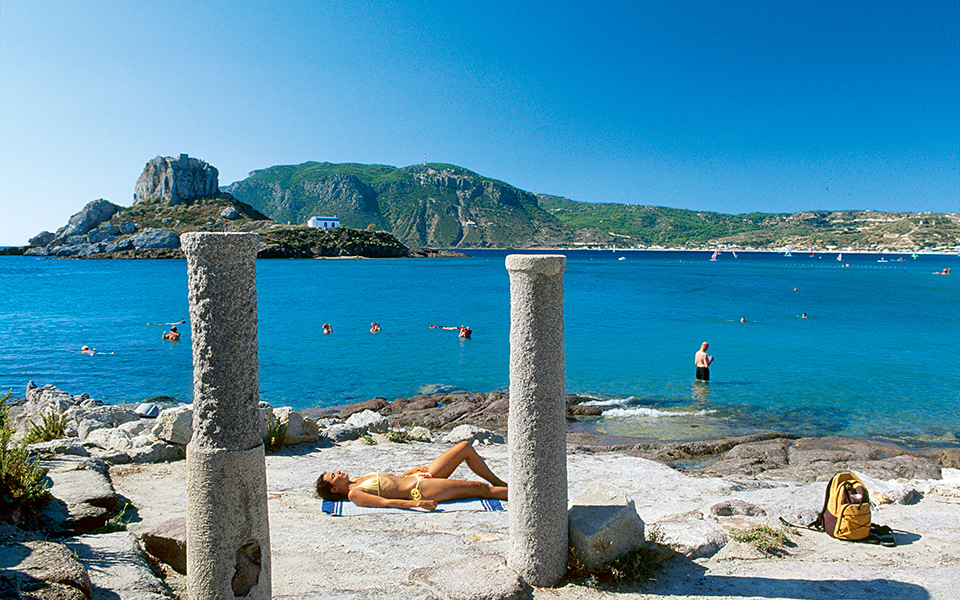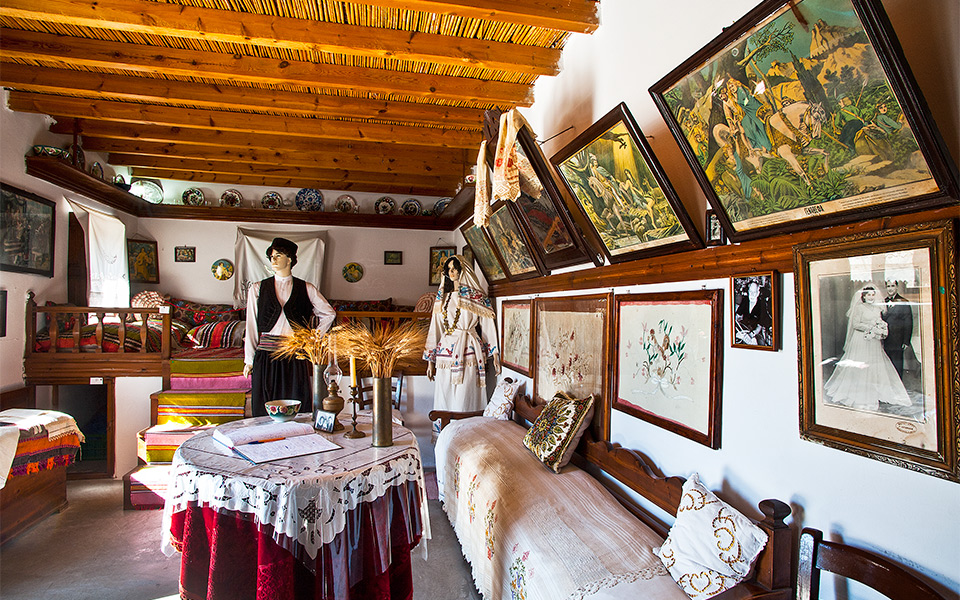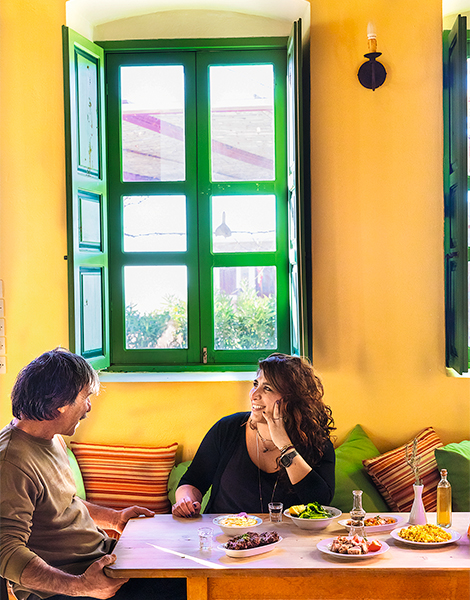Santorini Beyond the Crowds: What to See and...
Discover hidden beaches, authentic tavernas, ancient...

A sunbather near the ruins at Aghios Stefanos
© VisualHellas.gr
One of the most famous images of Kos is undoubtedly the beach of Aghios Stefanos (pictured top). Aside from being photogenic, this stretch of sand offers visitors one of the most popular island experiences as well. Here, at the beach located on the Bay of Kefalos, 40k from Kos Town, you can swim beside the remains of two paleo-Christian churches.
The churches were built in the 5th- 6th century AD on a promontory and have a view of the picturesque islet of Kastri. Today, you can clearly see their foundations, the arches of the main church, the columns and arches of the courtyards, the mosaic floors and sections of the baptisteries and altars. Archaeologists believe these were the most impressive of the dozens of ancient churches that once existed on the island.

House of Antimachia Folklore Museum
© Clairy Moustafellou
Antimachia is a largish village located 24k southwest of Kos Town. While a handful of traditional homes do still survive here, their elderly owners are unlikely to invite visits. “They’re somewhat ashamed that their houses are old, and that some still have reeds lining the ceilings,” explains Kyriakos Pappoulis, the president of the local cultural center.
Happily, visitors do have an alternative to peeking into private dwellings; the House of Antimachia Folklore Museum, a recreation of a typical early-20th c. home. The building includes a main living room with a raised wooden platform that served as a bed, as well as a cellar, where the family would have stored homemade foodstuffs like cured meat, grain, oil and pulses. There’s a large stone oven; an area where clay jars and pots containing drinking water were kept; a small barn for livestock and the sty where a single pig was raised to provide meat for the entire year.
The loom in the house is not merely decorative: it is put to good use by local resident Dionysia Dipsela, who keeps the craft of weaving alive and offers classes to local residents over the winter months.
Open Mon-Sat 9:00-17:00, Sun 12:00-15:00 • Tel. (+30) 694.469.1226

© Clairy Moustafellou
The feast day of Saint George (each April 23rd unless it conflicts with the Holy Week) is celebrated on Kos with a horse race, an age-old custom that brings almost the entire population to the village of Pyli. The celebration starts with a pro- cession of the saint’s icon, followed by a parade of around 40 riders and then by the race itself.
The contest usually involves around 20 young riders who have spent all year training on the beach for the big day. According to tradition, the bishop will “anoint” the winning horse by breaking an egg over it before bestowing it with the winner’s ribbon. The rider of the winning horse gets a prize, too, as do the runner-up and third-place jockeys.

A group of young dancers in traditional dress
© Clairy Moustafellou
Almost every city and town in Greece has a Lyceum of Greek Women, an institution that upholds Greek traditions, amassing and protecting priceless collections of costumes and archival material while passing down local and regional customs through traditional dancing and music classes.
The Lyceum of Kardamena has over 100 members, 80 of whom are children. In the summer, the dancers-in-training put on traditional costumes and perform at local festivals and events.

The Castle of Antimachia
© eorge Papapostolou, Giannis Papapostolou, Ministry Of Culture & Sports/Ephorate Of Antiquities Of Dodecanese
If you want to see Antimachia Castle at its best, try to get there as the setting sun casts its warm glow over the battlements. While at first sight it may not look like much of a strategic vantage point – perched on a promontory just 166m high – once you’ve explored it, you’ll see why it was so important to the Knights of St. John, who built it in the 14th century to stand sentry over the strait between Kos and Nissyros as well as the entire Kardamena coastline.
The castle served as a safe haven for residents from nearby settlements and other parts of the island during Turkish raids, and some of these people stayed on. The Turks made two failed siege attempts in 1457 and 1462, but when they took the island in 1523, they didn’t evict the fortress’s residents. The castle was gradually deserted in the mid-19th century as folk moved on to Antimachia and Kardamena, with the last Turkish soldiers withdrawing in 1871.
The site is open to the public and its highlights – in addition to its amazing panoramic view – include the churches of Aghia Paraskevi and Aghios Nikolaos. The former has a cistern that was used to collect rainwater, which was then distributed throughout the settlement, a feature that is rarely seen in churches from this period. Also keep an eye out for the still-extant coat-of-arms of Grand Master Pierre d’Aubusson and the Order of St. John on one of the castle’s gates. Antimachia Castle is located 24k from Kos Town.

The Acta Amateur Theater Group
© Giannis Papapostolou
The old abattoir at Aghios Vasilios in Kos Town now serves as the home of the Acta Amateur Theater Group (also known as the Theater Drama Workshop). Every summer, the group regales locals and visitors alike with its repertory of children’s plays, comedies and dramas, performing not only on the abattoir stage but also at monuments, castles and village squares around the island. This year’s plans include a production at the Roman Odeon in Kos Town.
Acta was created in 1994 by local director Vassilis Panagiotou (who has since passed away) and at that time comprised mainly students. Over the years, it has also attracted foreign talent living on the island, including a musician from Cape Verde, a Welsh actor and a French photographer, and this year it has also been joined by two foreign actresses, one Finnish and the other French, two Serbians (set and costume designers) and a Czech choreographer.
What is impressive about the group is that, while it is made up of amateurs, it puts on very professional, well-polished shows that are popular with foreigners even though they’re performed in Greek.
www.facebook.com/actakos • Tel. (+30) 697.855.6206

Yiannis Zoumbas, the last of the basket weavers
© Clairy Moustafellou
There was a time when the people of Kos couldn’t live without a sturdy basket: these items were used to carry fresh produce and goods from farms to village homes and even down to the port, where they were loaded onto ships for export. Professional basket-weavers were highly skilled craftsmen who added oleander twigs to their wicker creations to give them more strength and durability.
Yiannis Zoumbas never made a living from his craft but, at the age of 85, he may be the last person on the island who excels at the art of basket-weaving, taught to him by his father, a refugee from Asia Minor who came to the island in 1922. Even though the islanders don’t really use baskets anymore, Zoumbas continues to make them and gives his wares away to the church, to the House of Antimachia Folklore Museum and even, on occasion, to lucky passersby.
What’s more, he hopes to pass on his skills as well, and is instructing some of the younger generation in his craft. You will find him weaving his beautiful baskets outside the coffee shop of the Church of the Virgin Mary.

Haihoutes Café
© Clairy Moustafellou
A nearly deserted village located on the hillside of Mt Dikeos, Haihoutes (also known as Aghios Dimitrios) was abandoned some 40 years ago and has since become a beautifully eerie ghost village, populated only by crumbling houses. A handful of fans of the village, however, have restored two of its beautiful old residences. One now houses a small folklore museum that presents the area’s history, while the other is home to Haihoutes Café, which serves coffee and drinks with meze and also holds the occasional jazz or Greek music night.
• Tel. (+30) 693.263.7905

© George Papapostolou
Deserted in the early 19th c., possibly during an epidemic, the medieval settlement of Palio Pyli on the hillside of Mt Dikeos is a world away from the hustle and bustle of the island’s seaside resorts. Among its ruins, you can explore the Byzantine churches of Panaghia Kastriani, Aghios Antonios and Taxiarches – all three with some lovely murals and with ancient architectural elements.
Historians believe that this castle town was established thanks to the Monastery of Panaghia Kastriani, which was founded in the 11th c. by Hosios Christodoulos, and was further developed by the Knights of St. John to protect residents from Turkish raids.
The walk up to the castle only takes about 20 minutes. It’s a tough, uphill hike but you’ll be rewarded with an amazing view stretching all the way to the islands of Kalymnos and Pserimos and to Bodrum on the Turkish mainland. After your visit, sit down for a meal at the Oria Taverna, a good reason in its own right to visit the area. Palio Palio Pyli is located 16k from Kos Town

© Clairy Moustafellou
Anthippi Deliou decided not to give away her grandmother’s loom to some folklore museum, as most women do in rural Greece. Having learned the art of argalios from her mother and further enriching that knowledge by attending seminars, she opened a shop and made use of this traditional craft. You will find her, along with two elderly aunts who still lend a hand, in Kardamena, busy weaving rugs, carpets and bags in the traditional fashion.
Kardamena • Tel. (+30) 694.491.1380

There are about 13km of bike lanes in Kos town
© Dionysis Kouris
Kos is a great place to get around by bicycle. Many locals use bicycles to get to work or just enjoy a ride around town, and there are also a lot of rental stores offering a range of bicycles – from street and mountain bikes to two-seaters – as well as safety gear. The main bicycle road runs about 13km, from Faros Βeach to the far end of Psalidi, with lots of little side paths, too.
If you want to explore the island beyond the main town, there are trails crisscrossing its hills and mountains – some are dirt paths and some are on paved roads with limited traffic. One of the most popular routes leads from Kos Town through Tigaki and on to the beautiful beaches of Marmari. While islanders are accustomed to seeing cyclists on the road, you are advised to exercise caution and make sure to comply with traffic regulations.

Flamingoes in the Alyki wetlands on kos
© George Papapostolou
Hundreds of flamingoes spend the winter in the balmy Alyki wetlands, near the village of Tigaki, offering a spectacular sight – and not just for birdwatchers. These impressive pink-feathered birds tend to turn up in Kos around October and stay through March, stealing the show from the other 215 species recorded here. Up until the late 1980s, the Alyki wetlands was a salt flat, producing cooking salt.

The Kazino Cafe
© Dionysis Kouris

The fully functioning Amallos Mill in Antimachia
© Clairy Moustafellou
In the 19th century, Kos had 40 fully operational windmills (and just as many watermills), but only one of them is still active and producing flour. The Amallos Mill in Antimachia is open to visitors and, if you’re lucky, you may even come across its owner, Elpidoforos Amallos, who grew up right here at the mill and is always happy to share a story or two.
Approximately a decade ago, he began restoring the structure, which had been left idle by his father. He found experts to study the original workings of the mill and imported wood from Africa for the rebuilding. The official guided tours of the facility, however, are conducted by Antonis Avgerinos, an expert on mills who supervised the restoration. Open daily 9:00-17:00
Between Kos Town and Zia is Asomatos, a village that seems to have been overlooked in the rush to develop tourism. The Kazino café sits opposite the church, in the same spot it has occupied since 1906. Its current owner, Dimitris, has undertaken to preserve the slow-paced and unpretentious hospitality.
His son works in the kitchen preparing plates of meze and his daughter waits the tables. The menu is changeable, but you’ll always find seasonal vegetables, eggs with pork, good tsipouro and interesting musical selections from Dimitris’ vast vinyl collection. The downside is that you might find it closed when you finally arrive. Asomatos is located 14k from Kos Town.
Tel. (+30) 22420.302.41

The islet of Kastri near Kefalos
© CLairy Moustafellou
The old village of Kefalos is 45km from Kos Town and is the island’s most remote settlement; locals have their own dialect (including Homeric words and ancient inflections), and their own customs. They even have their cemetery in the middle of the village, something that is now very rare in Greece.
The people of Kefalos admit that they are somewhat skeptical of their fellow islanders – a feeling that is reciprocated – but they have been very welcoming to the dozens of foreign residents who moved to the village for its temperate climate. From here, there is a striking panoramic view down to Kefalos Gulf.
After exploring the local castle, narrow streets and stairways, why not head down to the sea, to either the small harbor of Kamari or the beach of Aghios Stefanos for a meal or a swim?

The sunset from Zia
© George Papapostolou
Zia is to Kos what Oia is to Santorini: the spot where everyone gathers to watch the spectacular sunset, where cafés and restaurants jostle for the best view of the sun sinking behind the nearly islands of Kalymnos and Pserimos.
Zia is one of the busiest tourist spots on the island, but if you’re looking for some romantic solitude, catch the “solar show” from any vantage point on the road leading from Kos Town to the villages on Mt Dikeos. Zia is located 15k from Kos Town.

Stamatis Galathris’ idea, 60 years ago, to start producing soft drinks using fresh citrus juice, bore fruit and turned into a remarkable success story. The Natur brand is a Kos trademark, producing orange and lemon drinks, fizzy lemon-lime, Kos Cola and 10 more flavors available at restaurants and mini-marts on the island.
Marmaroto, Tel. (+30) 22420.230.11
Discover hidden beaches, authentic tavernas, ancient...
Swim in thermal springs, explore untouched...
A summer mix of cultural events...
A wild, storied island where the...